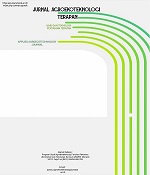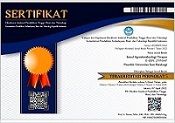Performance Test Of Teta22® Small-Scale Coconut Husk Processing Equipment
DOI:
https://doi.org/10.35791/jat.v3i2.45345Abstract
Efforts to maximize the utilization of coconut derivative products are still being carried out in coconut production centers. North Sulawesi as one of the highest coconut-producing regions in Indonesia is still trying to increase the value of existing coconut products. One of the problems faced in increasing the value of coconuts is the decreasing number of workers who climb and peel coconuts. Coconut coir as a very significant part of the amount in one fruit still needs attention so that its value can be increased. Coconut coir has the potential to be utilized but requires processing equipment, which can decompose coconut coir into fiber (coco fiber) and dust (cocopeat). The problem is that decomposers are relatively difficult to obtain in this area, and if they are available, they have to be imported from other islands and they are expensive. For this reason, this research was made, namely to make and test the performance of coconut coir processing equipment. The research method was carried out experimentally, and the data obtained were analyzed descriptively. Experiments were carried out using the engine rotation speed: 500 rpm, 600 rpm, and 700 rpm. The raw material for coconut fiber used was 10 kg with three repetitions. From the results of the study, it was found that the best results were at a speed of 500 rpm which was able to produce the highest yield of 90.9 percent of total cocopeat and coco fiber, while at speeds above 500 rpm, namely 600 rpm and 700 rpm, the higher the coir material that became granules dust. The highest decomposition yield of coir into coco fiber was at 500 rpm, namely 95.68 kg/hour or as much as 765.44 kg/day (note: 1 day = 8 hours). To increase comfort, further research can be directed at ergonomic testing to increase the comfort and safety of using the tool.
Keywords: Coconut husk, cocopeat, coco fiber, performance test, decomposition machine.
Abstrak
Upaya pemanfaatan maksimal dari produk turunan kelapa masih terus dilakukan di daerah sentra produksi kelapa. Sulawesi Utara sebagai salah satu daerah penghasil kelapa tertinggi di Indonesia masih terus berupaya untuk meningkatkan nilai dari produk kelapa yang sudah ada. Salah satu permasalahan yang dihadapi dalam peningkatan nilai kelapa adalah semakin berkurangnya tenaga kerja yang pemanjat dan pengupas kelapa. Sabut kelapa sebagai bagian yang sangat signifikan jumlahnya dalam satu buah, masih perlu perhatian untuk dapat ditingkatkan nilainya. Sabut kelapa berpotensi untuk dimanfaatkan akan tetapi perlu alat pengolah, yang dapat menguraikan sabut kelapa menjadi serat (cocofiber) dan debu (cocopeat). Permasalahannya adalah alat pengurai relatif sulit didapat di daerah ini, dan bila ada harus didatangkan dari pulau lain serta harganya mahal. Untuk itulah penelitian ini dibuat yaitu membuat dan menguji kinerja alat pengolahan sabut kelapa. Metode penelitian dilakukan secara eksperimental, data yang didapatkan di lakukan analisis secara deskriptif. Percobaan dilakukan menggunakan kecepatan perputaran mesin: 500 rpm, 600 rpm, dan 700 rpm. Bahan baku sabut kelapa yang digunakan sebanyak 10 kg dengan tiga kali ulangan. Dari hasil penelitian didapati bahwa hasil terbaik, adalah pada kecepatan 500 rpm yang mampu menghasilkan rendemen tertinggi sebesar 90,9 persen total cocopeat dan cocofiber, sedangkan pada kecepatan di atas 500 rpm, yakni 600 rpm dan 700 rpm, semakin tinggi bahan sabut yang menjadi butiran debu. Hasil penguraian tertinggi sabut menjadi serat sabut kelapa pada kecepatan 500 rpm, yaitu 95,68 kg/jam atau sebanyak 765,44 kg/hari (catatan:1 hari= 8 jam). Untuk meningkatkan kenyamanan, penelitian lebih lanjut dapat di arahkan pada pengujian ergonomis untuk meningkatkan kenyamanan dan keamanan penggunaan alat.
Kata Kunci: Sabut kelapa, cocopeat, cocofiber, uji kinerja, mesin pengurai
Downloads
Published
How to Cite
Issue
Section
License
Copyright (c) 2023 Telinus Yigibalom, Dedie Tooy, MS, PhD, Leo Kalesaran

This work is licensed under a Creative Commons Attribution-NonCommercial 4.0 International License.

This work is licensed under a Creative Commons Attribution-NonCommercial 4.0 International License.





















